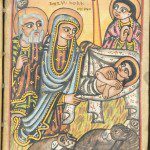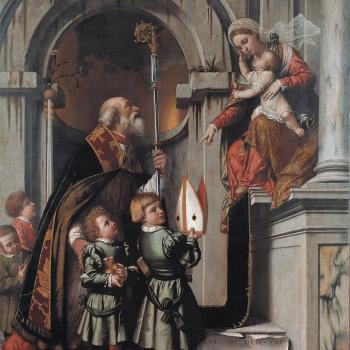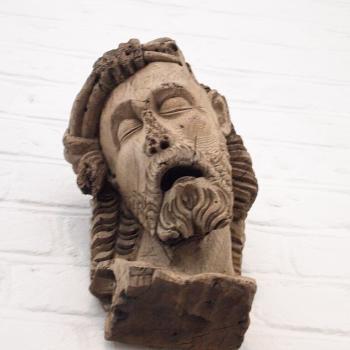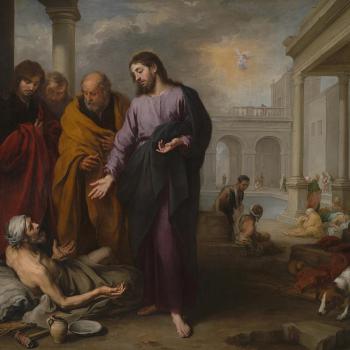![Isaiah worshipping the Virgin Mary and Child Jesus, Early 13th century. Saint Catherine's Monastery, Sinai (Egypt) / K. Weitzmann: "Die Ikone"See page for author [Public domain], via Wikimedia Commons](https://wp-media.patheos.com/blogs/sites/637/2016/06/Isajah__Mary_Icon_Sinai_13th_century-232x300.jpg)
Central to a proper understanding the Mosaic Law is to see how it pointed to and prefigured Christ, representing him in symbolic form. The letter of the law, which had value in a particular time and place, was not meant to be universalized. It must not be seen as if it were the presentation of natural law which was to be simply followed by all. Rather, as we previously explained, the Mosaic laws were put in place to help shape the people of Israel so that the messianic line could be established. But their other and universal significance lay with the way they pointed to the coming of Jesus Christ, and the life which we find when we understand the spirit behind the law. Hence, St Paul exclaimed, “Such is the confidence that we have through Christ toward God. Not that we are competent of ourselves to claim anything as coming from us; our competence is from God, who has made us competent to be ministers of a new covenant, not in a written code [letter] but in the Spirit; for the written code [letter] kills, but the Spirit gives life” (2 Cor. 3:4-6 RSV).[1] The text of the Mosaic Law, when read in a positivistic, literal sense (that is, “the letter of the law”) easily leads us astray because we fail to understand the spirit of the law, what its true purpose and intent is. This is why when the letter of the law is pushed and followed to the exclusion of its purpose and meaning, we find ourselves turning away from where the Spirit leads, turning us away from the life which Christ came to give us. When we push for the letter of the law, we fail to follow its proper intent and meaning, and so will close ourselves off from ways God offers us grace, including in and through the proper use of images.
The historical context in which the Ten Commandments were proclaimed should help us understand why, for the people of Israel, the use of images was extremely limited. The command was given before the incarnation and reflected the historical reality of the time. It represented the divide between God and humanity which would only later be overcome by God in his assumption of humanity unto himself. For the people of Israel, God came to them as the absolute who transcended all human comprehension, all human attempt to imagine him. God by his nature is invisible, and so the rejection of the use of images helped present this fact. How could God by imagined if he is himself invisible? Those at the time who tried to do so went to the pagans and employed their images for themselves, and since they had no proper way to adapt those images and purify them, they were led astray into grave error. It was in this fashion Sergius Bulgakov explained:
Nevertheless, precisely because of the religious temptation it represented, paganism posed such a danger for the chosen nation that the Old Testament’s entire attitude toward pagan art was determined by motives of religious pedagogy. Pagan art remained under a religious prohibition for Israel, and all idolatrous tendencies – such as those manifested by kings who began to serve pagan gods – were regarded as a religious fall.[2]
Therefore the law against graven images, in its context, was meant to teach the people of Israel about the transcendent, immaterial, spiritual and invisible nature of God. We must not create an image of him as if we could depict the divine nature itself. And yet, God, in showing that the letter of the law must not be understood as an eternal and absolute command, had Moses construct the Ark of the Covenant with the cherubim, had him raise up the bronze serpent, and later, Solomon also had cherubim inscribed on the walls of the temple (cf. 2 Chron. 3:1-14). Bulgakov rightfully stated that God rejected simplistic art representing the divine nature but yet gave indication that religious art could and would have a place: “This image of the two cherubim, […], already represents a fundamental recognition of both the rights and the possibilities of religious art, as well as the possibility of portraying the spiritual world with the resources and images of this art, although pedagogically it is limited in quantity.”[3]
Religious images created by those living in the Old Covenant demonstrated the possibility of religious art, but the time before the incarnation was the time in which revelation was yet to be completed, and so religious art had to be extremely limited in its use and application. If the law had no spiritual purpose behind it, the use of such images would have been completely forbidden. But they were not, and so we must find and understand the purpose of the law and use it when we find ourselves in our new context, that of the time after the incarnation. Now, for us in Christ, images can and do have a foundation for their use so that when we employ them, we do not have to follow the mistakes of the pagans and construct erroneous assumptions about the kingdom of God. Now they can and do point us to the truths of the Christian faith revealed to us in and through the incarnation. Christ validated the proper use of images by containing one in himself in and through his body, as St John of Damascus proclaimed:
In former times God, who is without body or form, could never be depicted. But now when God is seen in the flesh conversing with men, I make an image of the God whom I see. I do not worship matter; I worship the Creator of matter who became matter for my sake, who willed to take His abode in matter; who worked out my salvation through matter. Never will I cease honoring the matter which wrought my salvation! I honor it, but not as God.[4]
The spirit of the law is still in effect, but the letter which entirely forbade the use of all images was never followed, even by Moses. In this way, when we understand its meaning, we can see we are fulfilling the law even if and when we use images to represent Christ and the saints. Its point remains: we must not have anything which is treated as an absolute apart from God, and God in his nature, in his divinity, transcends all attempts to imagine him. And so we find in Israel, until the incarnation, the use of images often led the people astray, for by them and with them, they constructed false notions of God. Images were made out of speculation over the nature of God instead of letting God reveal himself and using the revelation to be the focus of how he was to be understood and imagined. Thanks to the incarnation, we have in Jesus Christ, in his person, the fullness of the revelation of God. He has revealed himself with images, images which we can use to depict him, and images which we can use to understand and represent the whole economy of salvation. Mary, the Mother of God, prefigured in the Ark of the Covenant, is to be granted her image, and likewise the saints, the friends of God, because they have joined themselves to Christ and are to be imagined because they participate in and share in the glory of Christ.[5]
Thus, it is absolute devotion of a relative good which is forbidden, because such a form of worship turns the relative into an absolute and misrepresents the absolute. We must not transfer this rejection of the absolutization of the relative into a denial of the value of such relative goods and the praise a relative good deserves. Throughout Scripture, we find praises of God’s creation as well as praises for the deeds of God’s friends the saints, such as the Patriarchs Abraham, Isaac and Jacob. By honoring the good done by those who worked with God, as well as the people who did that good, we are rendering honor not only to them, but also to God. We must always recognize the relative value of the good and not confuse it for the absolute good of God: it is a relative good which participates in the absolute, and so it is in accordance to its relative level of goodness we can and should honor such a good. But we must also recognize that when we honor the relative good in this way, we are also honoring even more the absolute good, from which that good comes from, and to deny such veneration of the relative good is, as we have said before, a denial of the good and so renders to the absolute good a denial of some of its good as well.
More to Come
[1] “Written code” is better, and most usually translated as letter, as I put in brackets.
[2] Sergius Bulgakov, Icons and the Name of God. trans. Boris Jakim (Grand Rapids, MI: William B Eerdmans Publishing Company, 2012), 5.
[3] ibid., 6.
[4] St. John of Damascus, On the Divine Images. trans. David Anderson (Crestwood, NY: St Vladimir’s Seminary Press, 1980; second edition, 1994), 23.
[5] “Abide in me, and I in you. As the branch cannot bear fruit by itself, unless it abides in the vine, neither can you, unless you abide in me” (John 15:4 RSV)
“I have been crucified with Christ; it is no longer I who live, but Christ who lives in me; and the life I now live in the flesh I live by faith in the Son of God, who loved me and gave himself for me” (Gal. 2:20 RSV)
“For as many of you as were baptized into Christ have put on Christ” (Gal. 3:27 RSV).
Stay in touch! Like A Little Bit of Nothing on Facebook:
A Little Bit of Nothing













